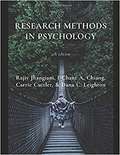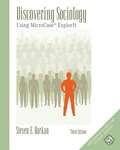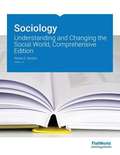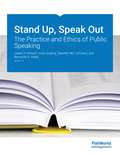- Table View
- List View
Research Methods In Psychology
by Rajiv S. Jhangiani I-Chant A. Chiang Carrie Cuttler Dana C. LeightonA comprehensive textbook for research methods classes. A peer-reviewed inter-institutional project. This adaptation constitutes the fourth edition of this textbook, and builds upon the second Canadian edition by Rajiv S. Jhangiani (Kwantlen Polytechnic University) and I-Chant A. Chiang (Quest University Canada), the second American edition by Dana C. Leighton (Texas A&M University-Texarkana), and the third American edition by Carrie Cuttler (Washington State University) and feedback from several peer reviewers coordinated by the Rebus Community. This edition is licensed under a Creative Commons Attribution-NonCommercial-ShareAlike 4.0 International License.
Research Methods in Psychology
by Paul C. PriceYears before this book was a Flat World Knowledge textbook, Paul Price wrote an extensive series of handouts to replace the textbook he had been using for his psychological research methods course, and he posted them online for his students. The advantages of this were that 1) students had a streamlined presentation of the most important methodological concepts in psychology, and 2) they could access it online for free. Paul turned his book into a proper textbook by having it reviewed, edited and published with the full set of ancillaries by Flat World Knowledge so not only could his students get the materials for free, but so could yours. Although the content of Research Methods in Psychology is fairly traditional--making it easy for you to use with your existing courses--it also emphasizes a fundamental idea that is often lost on undergraduates: research methods are not a peripheral concern in our discipline; they are central. This why the overarching goal of this textbook is to present the basics of psychological research methods--focusing on the concepts and skills that are most widely shared within the discipline--emphasizing both their centrality to our field and their contribution to our understanding of human behavior. The book will include several features that will help accomplish this overarching goal. The Core Concepts: Dr. Price based his choices about content and terminology on the most influential original books and articles in the research methodology literature--as determined by an empirical analysis of the reference lists of secondary sources. He also relied on the Undergraduate Psychology Major Learning Goals and Outcomes document commissioned by the APA. Although many of the research methods outcomes in that document are addressed in all research methods textbooks (e.g., "Describe how various research designs address different types of questions and hypotheses"), others are rarely mentioned (e.g., "Recognize the limitations of applying normative conclusions to individuals"). The Examples: The text includes examples drawn from the entire range of contemporary psychology, including abnormal, clinical, and counseling psychology. Dr. Price also chose examples to show how psychological research has fundamentally changed what we believe to be true about human behavior (for example, in the area of eyewitness memory). The Style: Dr. Price concentrated on making the style of this book both straightforward and engaging. If you are looking for a new research methods textbook for your psychology course that has been used by "teachers" and is thorough in its content, you will find your book in Paul Price's Research Methods in Psychology. Order a desk copy and see for yourself.
Rimjhim (II) class 2 - Ncert
by NcertThis book prescribed by central board of secondary education, India for the students of class 2 subject Hindi. This accessible version of the book doesn't leave any part of the book. The book is handy companion of the school going students.
Risk Management for Enterprises and Individuals
by Etti Baranoff Patrick Lee Brockett Yehuda KahaneThis book is intended for the Risk Management and Insurance course where Risk Management is emphasized. When we think of large risks, we often think in terms of natural hazards such as hurricanes, earthquakes or tornados. Perhaps man-made disasters come to mind such as the terrorist attacks in the U.S. on September 11, 2001. Typically we have overlooked financial crises, such as the credit crisis of 2008. However, these types of man-made disasters have the potential to devastate the global marketplace. Losses in multiple trillions of dollars and in much human suffering and insecurity are already being totaled, and the global financial markets are collapsing as never before seen. We can attribute the 2008 collapse to financially risky behavior of a magnitude never before experienced. The 2008 U.S. credit markets were a financial house of cards. A basic lack of risk management (and regulators' inattention or inability to control these overt failures) lay at the heart of the global credit crisis. This crisis started with lack of improperly underwritten mortgages and excessive debt. Companies depend on loans and lines of credit to conduct their routine business. If such credit lines dry up, production slows down and brings the global economy to the brink of deep recession or even depression. The snowballing effect of this failure to manage the risk associated with providing mortgage loans to unqualified home buyers have been profound, indeed. When the mortgages failed because of greater risk- taking on the Street, the entire house of cards collapsed. Probably no other risk-related event has had, and will continue to have, as profound an impact world wide as this risk management failure. How was risk in this situation so badly managed? What could firms and individuals have done to protect themselves? How can government measure such risks (beforehand) to regulate and control them? These and other questions come to mind when we contemplate the consequences of this risk management fiasco. Standard risk management practice would have identified sub-prime mortgages and their bundling into mortgage-backed-securities as high risk. People would have avoided these investments or would have put enough money into reserve to be able to withstand defaults. This did not happen. Accordingly, this book may represent one of the most critical topics of study that the student of the 21st century could ever undertake. Risk management will be a major focal point of business and societal decision making in the 21st century. A separate focused field of study, it draws on core knowledge bases from law, engineering, finance, economics, medicine, psychology, accounting, mathematics, statistics and other fields to create a holistic decision-making framework that is sustainable and value- enhancing. This is the subject of this book.
Sexuality and Our Diversity: Integrating Culture with the Biopsychosocial Version 1.0
by Marcus TyeSexuality and Our Diversity: Integrating Culture with the Biopsychosocial by Marcus Tye explores, with an integrated approach, the complex dimensions of biology, culture, psychology, sociology, history, and philosophy that explain human sexual diversity. While this text is primarily focused on the present, it also explores selected aspects of history to lend perspective to students that contemporary controversies have deep historical roots.
Signals and Systems
by Thanh Dinh VuThe course provides students basic knowledge about signals, sampling, time domain analysis of signals, frequency domain analysis of signals.
Signals, Systems, and Society
by Carlos E. DavilaThis textbook gives an introduction to signals, transforms, systems, and strives to present the material in a societal context.
Six Steps to Job Search Success
by Caroline Ceniza-Levine Connie Thanasoulis-CerrachioThis book is a practical discussion of actionable steps (six of them!) that students can take to land a job regardless of the market. Whether the estimate is 25% unemployment or single-digit unemployment, that number doesn't apply to any one student. For any individual, the unemployment rate is 0% or 100%. One either has a job or doesn't. When any one person is looking for a job and there is 10% unemployment, that person just wants to be one of the nine people that has a job. Students might think even that one job is beyond their grasp. They think they don't have the right degree. Their school is in a different location than where they'd like to work. Not enough jobs are listed or employers are visiting the campus. This type of thinking cedes control of a student's search to outside forces. It is not up to professors, schools, career services support, or recruiters to get students a job. This book is about the proactive things that students can do to get themselves a job.
Small Business Management in the 21st Century
by David T. Cadden Sandra L. LuederSmall Business Management in the 21st Century offers a unique perspective and set of capabilities for instructors. The authors designed this book with a "less can be more" approach, and by treating small business management as a practical human activity rather than as an abstract theoretical concept. The text has a format and structure that will be familiar to you if you use other books on small business management. Yet it brings a fresh perspective by incorporating three distinctive and unique themes and an important new feature (Disaster Watch) which is embedded throughout the entire text. These themes assure that students see the material in an integrated context rather than a stream of separate and distinct topics. First, the authors incorporate the use of technology and e-business as a way to gain competitive advantage over larger rivals. Technology is omnipresent in today's business world. Small business must use it to its advantage. We provide practical discussions and examples of how a small business can use these technologies without having extensive expertise or expenditures.
SOCIAL AND POLITICAL LIFE-I Class 6 - competitive exam - NCERT
by NcertThis book prescribed by central board of secondary education, India for the students of class 6th subject Social Science. This accessible version of the book doesn't leave any part of the book. The book is handy companion of the school going students.
Social Problems
by Steven E. BarkanSocial Problems: Continuity and Change by Steve Barkan is a realistic but motivating look at the many issues that are facing our society today. As this book's subtitle, Continuity and Change, implies, social problems are persistent, but they have also improved in the past and can be improved in the present and future, provided that our nation has the wisdom and will to address them. It is easy for students to read a social problems textbook and come away feeling frustrated by the enormity of the many social problems facing us today. Social Problems: Continuity and Change certainly does not minimize the persistence of social problems, but neither does it overlook the possibilities for change offered by social research and by the activities of everyday citizens working to make a difference. Readers of Steve Barkan's book will find many examples of how social problems have been improved and of strategies that hold great potential for solving them today and in the future.
Sociology
by Steven E. BarkanThis best selling software-based workbook lets students explore dozens of sociological topics and issues, using data from the United States and around the world. With the workbook and accompanying ExplorIt software and data sets, students won't just read about what other sociologists have done, they will discover sociology for themselves. DISCOVERING SOCIOLOGY will add an exciting dimension to the introductory sociology course.
Sociology: Understanding and Changing the Social World (Brief)
by Steven E. BarkanThe founders of sociology in the United States wanted to make a difference. A central aim of the sociologists of the Chicago school was to use sociological knowledge to achieve social reform. A related aim of sociologists like Jane Addams, W.E.B. DuBois, and Ida B. Wells-Barnett and others since was to use sociological knowledge to understand and alleviate gender, racial, and class inequality. It is no accident that many sociology instructors and students are first drawn to sociology because they want to learn a body of knowledge that could help them make a difference in the world at large. Steve Barkan's Sociology: Understanding and Changing the Social World is designed for this audience. It presents a sociological understanding of society but also a sociological perspective on how to change society, while maintaining the structure and contents of the best mainstream texts. Several pedagogical features of the book convey the sociological perspective and change theme: Almost every chapter begins with a Social Issues in the News story from recent media coverage that recounts an event related to the chapter's topic and proceeds with thought-provoking discussion about the social issue related to the event. Additional discussion elsewhere in the chapter helps students understand the basis for this issue and related issues. This dual treatment of the news story will help students appreciate the relevance of sociology for newsworthy events and issues. Three types of boxes in almost every chapter reflect the U.S. founders' emphasis on sociology and social justice. The first box, Sociology Making a Difference, discusses a social issue related to the chapter's topic and shows how sociological insights and findings have been used, or could be used, to address the issue and achieve social reform. The second box, Learning from Other Societies, discusses the experience in another nation(s) regarding a social issue related to the chapter; this box helps students appreciate what has worked and not worked in other nations regarding the issue and thus better understand how social reform might be achieved in the United States. The third box, What Sociology Suggests, summarizes social policies grounded in sociological theory and research that hold strong potential for addressing issues discussed in the chapter.
Sociology: Understanding and Changing the Social World
by Steven E. BarkanThe founders of sociology in the United States wanted to make a difference. A central aim of the sociologists of the Chicago school was to use sociological knowledge to achieve social reform. A related aim of sociologists like Jane Addams, W.E.B. DuBois, and Ida B. Wells-Barnett and others since was to use sociological knowledge to understand and alleviate gender, racial, and class inequality. It is no accident that many sociology instructors and students are first drawn to sociology because they want to learn a body of knowledge that could help them make a difference in the world at large. Steve Barkan's Sociology: Understanding and Changing the Social World is designed for this audience. It presents a sociological understanding of society but also a sociological perspective on how to change society, while maintaining the structure and contents of the best mainstream texts.
Sociology, Brief Edition, Version 1.2: Understanding and Changing the Social World
by Steven E. BarkanSteve Barkan presents a sociological understanding of society but also a sociological perspective on how to change society, while maintaining the structure and contents of the best mainstream texts. Version 1.2 of his “Brief Version” includes the most recent data on crime and victimization, income and poverty, life expectancy and aging, employment, marriage and divorce, education
Solid State Physics and Devices-the Harbinger of Third Wave of Civilization
by Bijay Kumar Sharma.In this collection we give the developments in Integrated Circuit Technology over the last 50 years as the Prologue. Next the main text is given. The main text covers the syllabus of Solid State Physics and Devices as well as the syllabus of Electronic Materials Science which is given in B.Tech Curriculum. The main text is concluded with Epilogue which covers the major socio-economic-political changes which have taken place with the advent of Solid State Physics.
Stand Up, Speak Out
by Jason S. Wrench Anne Goding Danette Ifert Johnson Bernardo A. AttiasThe two key themes to Stand up, Speak out: The Practice and Ethics of Public Speaking make it a welcomed addition to the choices you have for a public speaking textbook. First it focuses on helping students become more seasoned and polished public speakers, and second, its emphasis on ethics in communication. It is this practical approach and integrated ethical coverage that sets Stand up, Speak out: The Practice and Ethics of Public Speaking apart from the other texts in this market.
Sundae Fun-Day (Shopkins: Chapter Book)
by Judy Katschke Artful Doodlers Ltd.Peppa-Mint hears that the Cool Dream Ice Cream Parlor, her favorite spot in Shopville, is in danger of closing! She wants to help bring in business--but how? Join Peppa-Mint, Jessicake, Bubbleisha, and Donatina while they cook up a creative way to bring in new customers and save the hot fudge sundaes of Shopville! This original chapter book features fun illustrations on every spread.
Survey of Economics Version 1.0
by Libby Rittenberg Timothy TregarthenThis Survey of Economics textbook is intended for the one-semester introductory economics course. Building on the pedagogy developed in their successful two-semester Principles of Economics textbook, Libby and Tregarthen cover topics that will give students the tools to understand the economics way of thinking.
Sustainability, Innovation, and Entrepreneurship
by Andrea LarsonThis book is suited for the Entrepreneurship or Innovation course with an emphasis on Sustainability or for a course devoted entirely to Sustainability. The deep roots of sustainability thinking are now evident in widespread and increasingly visible activities worldwide, this text will help you and your students explore that necessity, its implications and its progression.
The Sustainable Business Case Book
by Ross Gittell Matt Magnusson Michael MerendaThe issue of sustainability and specifically sustainable business is of increasing interest and importance to students of business and also students in the sciences, government, public policy, planning and other fields. There can be significant benefits from students learning about sustainable business from the rich experiences of business practice. The Sustainable Business Case Book by Gittell, Magnusson and Merenda is one of the first of its kind. It combines the the theory of sustainability with key concepts, analytical information and contextual information with a collection of cases which provide insights, perspective and practical guidance on how sustainable businesses operate from different business functional area perspectives. The Sustainable Business Case Book can be used as a stand-alone text or as a supplemental textbook for undergraduate courses that have an interest in sustainable business. While the book's primary focus is on the relationship between business and sustainability, the book can also be used in courses offered in fields other than business, including environmental and earth systems sciences, environmental studies, urban planning, economics and public policy.





